


Download this guide as a PDF, 2749.87 KB.
This guide provides work health and safety information for road freight transport operators and their supply chains. It provides guidance relevant to New South Wales work health and safety (WHS) laws and is a useful resource for operators, drivers and all involved in the road freight transport industry.
The transport industry is an essential service provider for all Australians, but unfortunately records a high rate of fatalities and serious injuries. Therefore, the industry is a focus area in the Australian Work Health and Safety Strategy 2012 -2022 and a priority industry in SafeWork NSW’s Work Health and Safety Roadmap for NSW 2022 (Roadmap).
Please note, the Roadmap has been replaced by the SafeWork NSW Regulatory Priorities.
While road accidents are top of mind causes of fatalities and serious injuries, there are several high-risk activities for workers and others when the vehicle stops that contribute to incident and claim rates.
In 2018, SafeWork NSW launched the Transport Work Health and Safety Sector Plan (Transport sector plan) following consultation with our industry stakeholders to address these issues. Key priority areas were identified as well as the work activities that cause serious injuries and fatalities in the transport industry. The key priority areas are:
The Transport sector plan is informed by other key Roadmap strategies including:
In February 2018, the NSW Government released the Road Safety Plan 2021. This was developed to set new road safety priorities and actions to help NSW work toward the State Priority target of a 30 per cent reduction in road fatalities by 2021 (compared to 2008–2010 levels).
In support of the Road Safety Plan 2021, a guide has been developed which provides workplaces with information about key road safety issues and risks, and ways to help you and your workers get around safely while using the road. It also supplies information to help you embed road safety within your workplace.
If there is a serious injury or illness, a death or a dangerous incident, you must report it to us immediately on 13 10 50 as an urgent investigation might be needed.
You can notify SafeWork NSW of an incident 24 hours a day, 7 days a week on 13 10 50.
You must also:
A ‘notifiable incident’ under the work health and safety legislation relates to:
Examples of these incidents are available in Safe Work Australia's Incident notification fact sheet.
If you need further advice, call us on 13 10 50.
The Roadmap incorporates the concept of a work health and safety landscape and has been developed to aid all NSW workplaces including the transport sector to:
Please note, the Roadmap has been replaced by the SafeWork NSW Regulatory Priorities.
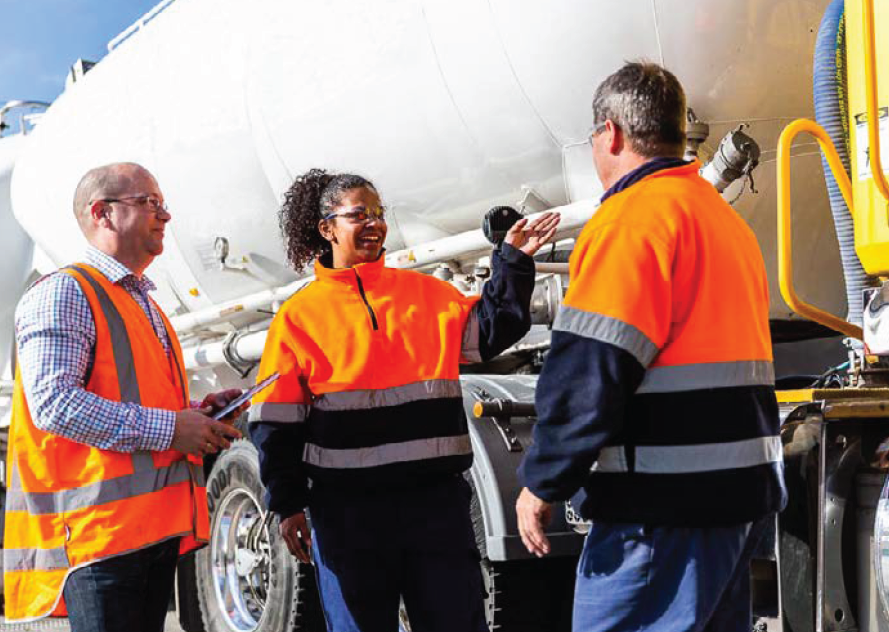
The ideal WHS landscape in the transport sector should include:
Consultation is an essential part of managing work health and safety in your workplace.
Businesses must consult with workers in situations when their health and safety is likely to be or is directly affected. Workers must have an opportunity to express their views and contribute to any decisions relating to their health and safety.
A consultation arrangement is the way that you consult with your workers. It can be as simple as talking to your workers regularly and considering their views when making health and safety decisions. Your workers must agree to the arrangement.
Consultation provides an opportunity to use the knowledge and experience of your workers to achieve a safer and healthier workplace.
See our consultation toolkit for more information.
You must consult with workers who are or are likely to be, directly affected by a health and safety issue in your workplace.
Your workers are affected by your decisions, so you must involve them in all work health and safety decisions. They can help you find better controls, improve decision-making and reduce incidents.
If you share work health and safety duties with another business or businesses, you must also consult with them and their workers.
You can consult with workers in a variety of ways, including:
HSRs are elected to represent workers on health and safety matters and have responsibilities under WHS legislation.
An HSR and deputy HSR play a pivotal role in gathering information about what the health and safety issues are for their work group. They can work out ways to resolve issues in consultation with business representatives such as managers and supervisors, as well as committees and other HSRs.
You can use a mix of consultation arrangements. When deciding how to consult with your workers, take into consideration:
Refer to the consultation toolkit for more information on how to consult.
Consultation must be regular and ongoing. You must consult with your workers when:
If you share work health and safety duties with another business, you must consult with them and their workers.
For example, transport operators and supply chain businesses should consult with each other on matters such as traffic management to ensure safe delivery and pick up at their sites.
If you have contractors or labour-hire workers, you share a duty of care and you must consult with the businesses that supply their services.
Transport is a diverse industry including outdoor work with heavy machinery and plant. Each workplace is different and work is undertaken at various locations along the supply chain. You need to know the hazards in your business so you can assess the risks they pose.
Transport operators and supply chain businesses have legal obligations under the work health and safety laws to manage hazards and risks associated with work in the business or undertaking. You must:
Hazard prevention includes:
Businesses need to identify hazards and assess the risk of harm to someone in the workplace. To be compliant with health and safety laws, you must then take reasonable steps to limit the risk.
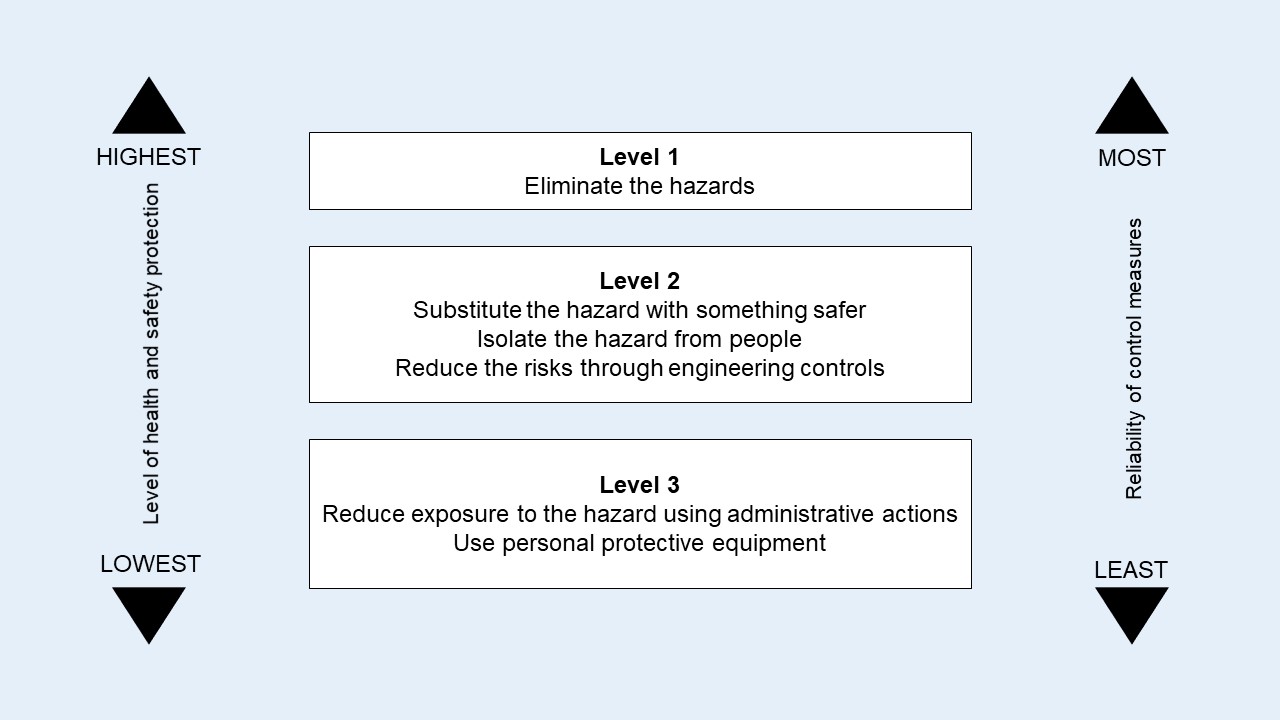
Whenever vehicles, mobile plant (such as forklifts) and pedestrian traffic interact; there is the increased potential for injury or death if traffic management arrangements are not in place or are inadequate.
A person hit by a forklift, moving vehicle or a shifting load will likely suffer serious injury or possibly death.
If you or your workers are involved in loading and unloading activities in the workplace you are most at risk.
Contractors and visitors to your workplace may also be at risk if traffic management systems are poor.
See the Incident Information Release to understand what can occur.
Effective traffic management procedures should be developed to suit the unique requirements of each individual workplace.
The nature of the workplace can determine not only the type and effectiveness of control measures that can be implemented, but also how often these control measures should be reviewed to ensure that they remain effective. These plans and procedures should be made available for contractors and be part of induction to site.
On 1 July 2020, completion of Traffic Control Work Training (TCWT) became a requirement under the Work Health and Safety Regulation. This means that workers in varying industries such as manufacturing, retail and construction will now be required to obtain a TCWT card.
Examples:
A worker cannot be directed to undertake traffic control work without the appropriate TCWT card. You must ensure that the worker has been recently trained (in the last two years) if they have not undertaken any traffic control work during that period. You should also check that they have an issued TCWT card. Check a NSW-issued licence.
For the specific laws about traffic control work training obligations, see sections 184A - 184N of the Work Health and Safety Regulation 2017.
There are also general work health and safety laws that will apply to you in any situation, including when supporting licensed workers.
Several business operators may be involved in loading/unloading freight in the workplace such as:
Under work health and safety legislation, each business shares the responsibility for the health and safety of those involved in the work, and the health and safety of others (e.g. pedestrians) who may be in the vicinity of the work. This duty is to the extent of their ability to influence and control the work. You must work together to ensure risks are eliminated, or if this is not possible, minimised.
Every workplace is different and will present different hazards and risks.
The most effective way of ensuring persons and vehicles move safely around a workplace is to provide separate pedestrian and vehicle traffic routes.
Ideally, the barriers used to separate people from plant will be permanently fixed, difficult to defeat and will be constructed to ensure all persons are protected. Where possible and practicable, introduce a one-way system as this will minimise the need for vehicles to reverse, and will help pedestrians and drivers.
Your circumstances might mean complete separation of vehicles and people is not possible or practicable. You may minimise the risks by:
Ensure forklift operators are appropriately instructed, trained, supervised and hold a current high-risk work licence for forklifts.
Refer to the forklifts page for various fact sheets, guides and posters you can download.
It is important to select the most appropriate control as implementing the wrong control measure can increase the risk, for example, reducing vehicle stability.
The general principles for safe traffic routes within the workplace are as follows:
Work areas should be suitably lit for drivers to see hazards and persons to see vehicles in the workplace.
Good visibility for drivers relates to vehicle speed and the distance required to stop or change direction safely.
Install mirrors where sharp or blind bends are found on traffic routes.
The workplace should have suitable and sufficient lighting in work areas where:
Provide levels of light to ensure there are no drastic and sudden changes that could lead to drivers being dazzled. For example, consider the time of day and sunlight.
The most effective way of reducing reversing incidents in the workplace is to remove the need to reverse by introducing one-way systems wherever possible.
Where reversing is necessary and unavoidable, consider the following:
Truck wheel stops can be installed and designed to withstand the weight of heavy vehicles and mobile equipment while driving and reversing into parking areas, loading and unloading.
Roadside delivery/pick-up introduces a number of hazards such as backing into busy streets, crossing footpaths, parking on public streets and interacting with the public.
It should be avoided where possible but where this is not reasonably practicable, adequate control measures need to be implemented.
Consider the use of barriers, signs, cones, lights or a licensed traffic control person. Also consider the ability of other road users to see the stationary vehicle and the loading/unloading operation and avoid contact.
You should include these considerations as part of your planning for safe loading/unloading in consultation with the delivery/pick-up site.
When loading/unloading from trucks, ensure the work has been planned for safety in consultation with those who will be undertaking the work, such as any mobile plant operators.
Consider the work environment where the loading/unloading will take place and:
It is also essential to put measures in place to ensure the truck cannot move during loading/unloading. Consider:
Before delivery/pick-up, information on the following should be provided (where applicable) to drivers:
As the transport operator, you should also provide supply chain businesses with any necessary information on the vehicle being used. For example, consider the dimensions of the vehicle in relation to the delivery/pick-up site.
Exclusion zones to separate non-essential workers from the loading/unloading area should be clearly established.
A safety zone for the driver should also be available and communicated.
Exclusion zone and safety zone considerations:
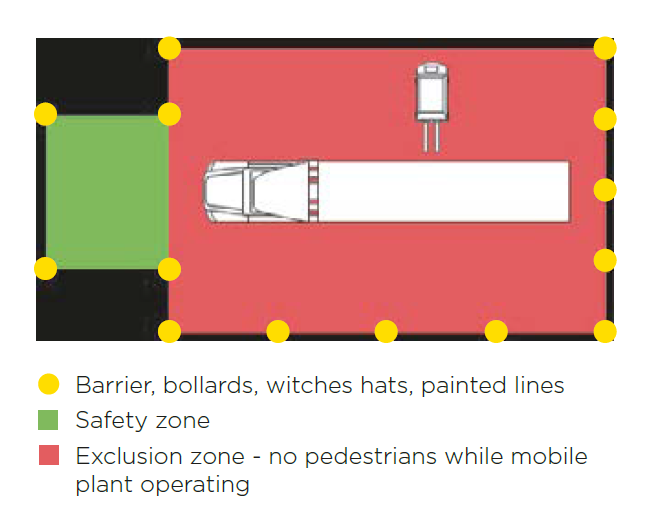
Clear and cooperative communication between workers loading/unloading is critical to prevent accidents. You should:
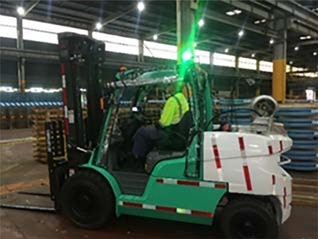
When the light is green the handbrake is on. When the amber light is on the forklift is operational.
The operation of forklifts, cranes and other mobile plant that are commonly used for loading/unloading operations may be categorised as a class of high risk work in the Work Health and Safety Regulation and require the operator to hold a high risk work licence.
A worker cannot be directed or allowed to carry out high risk work if they do not hold a licence for that class of work.
When mobile plant is being used for loading/unloading you:
For the specific laws about high risk work licensing obligations, see Part 4.5 of the Work Health and Safety Regulation 2017.
For the general duties of a business involving the management or control of plant, see Part 5.1 Division 7 of the Work Health and Safety Regulation 2017.
There are also general work health and safety laws that will apply to you in any situation, including managing risks associated with mobile plant.
Before loading or unloading, make sure:
A 65-year-old driver suffered fatal injuries when struck by two steel pipes as they were being unloaded from a heavy-vehicle trailer in Moorebank.
A telehandler, operating from the opposite side of the truck, was used to unload the pipes.
Read the Transport Incident Information Release.
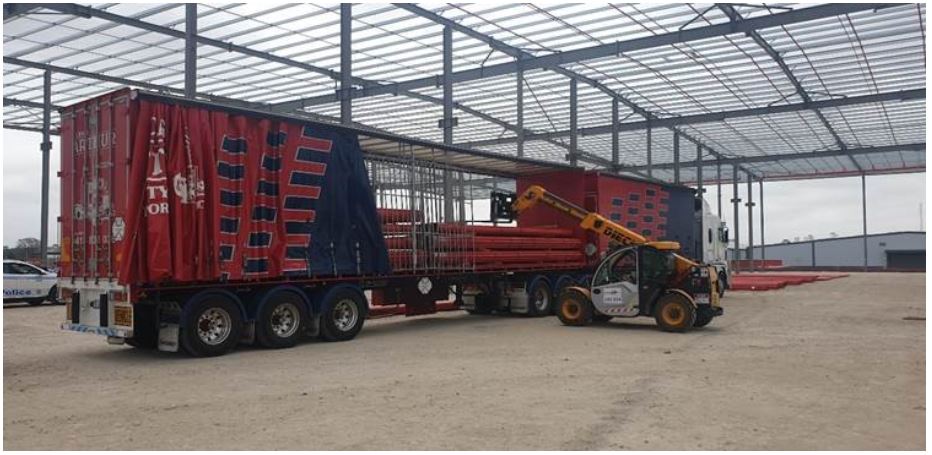
A 71-year-old male sustained fatal injuries while loading a car onto a tilt tray truck in Singleton NSW. It is believed that the car came off the tilt tray causing the worker to fall and strike his head on the pavement.
Read the Transport Incident Information Release.
Tilt tray truck involved in the incident.
Uncontrolled vehicle movements (or roll-aways) have been responsible for several deaths in NSW.
SafeWork NSW has investigated incidents where workers have been crushed when appropriate control measures were not implemented to effectively immobilise a vehicle.
A vehicle may be subject to uncontrolled movement when you:
Roll-aways can kill.
Keep drivers and others safe by:
See our safety alert for Immobilising heavy vehicles and trailers for more information.
Before starting work, always identify the hazards and assess the risks.
Drivers should:
Truck owners should:
Maxi brakes and wheel chocks should be fitted and used to prevent unintentional movement or rolling when parked or positioned on inclined surfaces.
Maxi brakes have two chambers; one that acts the same as a standard brake chamber, and a second chamber that contains a very powerful mechanical spring that acts as a fail-safe should the air brake system lose air pressure. The maxi brake also serves as a mechanical parking brake to prevent a trailer from rolling when parked on inclined surfaces.
Wheel chocks are designed to be used to prevent a vehicle from rolling backward or forward while parked, or while parked for maintenance work, unloading, loading, etc. Because there is a range of vehicle and trailer types and tire sizes, they’re manufactured in a variety of styles and from different materials. They are inexpensive and should be used to provide safety for those working around the vehicle.
A 58-year-old truck driver was fatally injured at a waste recycling facility at Camellia when, after exiting the cabin of a truck, he was pinned between the cabin and the door of the truck as it rolled into concrete blocks.
Read the Incident Information Release.
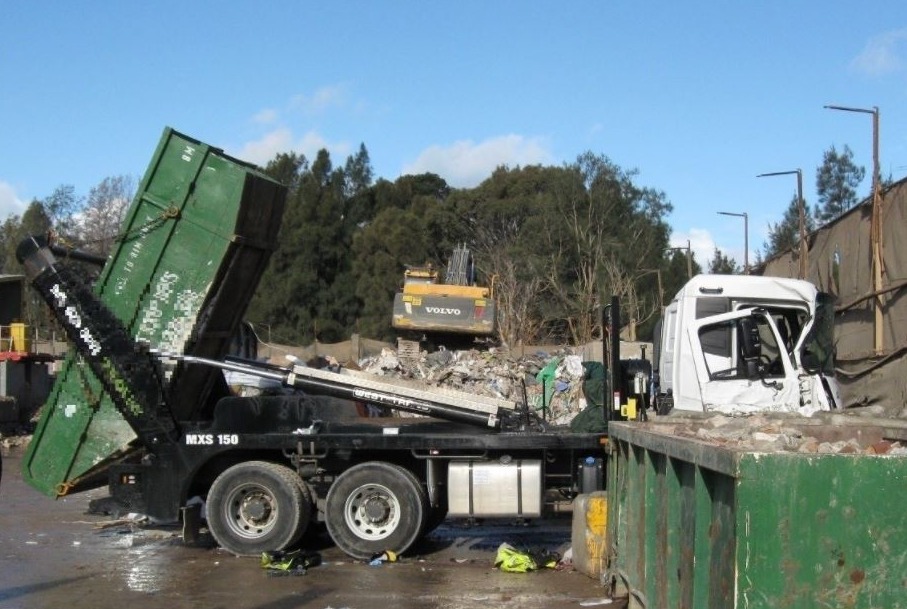
The truck involved in the incident.
Loads that aren’t properly secured can injure or kill people and cause significant property damage. This can happen on the road or during loading and unloading work.
The Load Restraint Guide 2018 provides users with the basic safety principles that should be followed when designing an appropriate load restraint system. The guide includes technical information, detailed diagrams and worked examples to assist users in determining the suitable restraints method.
Injuries are caused when:
To eliminate the risks associated with handling gates, consider whether you need them. There may be more suitable alternatives, such as:
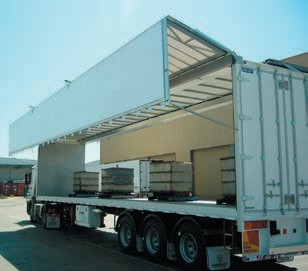
Truck with folding sides.
If it’s not reasonably practicable to eliminate the use of gates, consider gates that don’t need to be removed during loading/unloading (and can be retrofitted to the vehicle), such as:
Clean the tracks and rollers regularly.
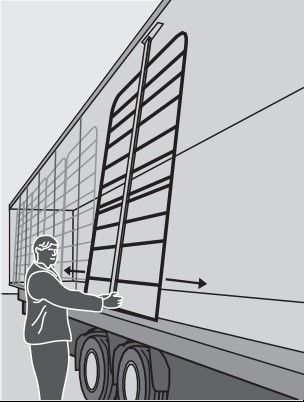
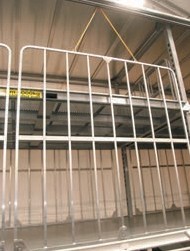
Left: Sliding gate. Right: Hanging gate.
Sliding panel.
The use of gates that can be removed from the vehicle involves a greater degree of manual handling and therefore should be avoided where possible. If used, these gates should be removed and installed from a solid platform that is a similar height to the truck tray, to ensure the gates are handled between shoulder and knee height. If the gates are tall and heavy, a minimum of two people should remove and install them.
A minimum of two people should be used if the gates are removed or installed from ground level unless the gates are short and light. Advise the delivery site in advance should the driver need help to remove the gates. Team handling should only be used until a more effective control can be implemented or for tasks that are undertaken rarely.
When opening and closing side-curtains:
Ensure the curtain track and rollers are regularly maintained and follow manufacturer instructions for lubrication; keep the track clean by using air, water or vacuum to remove dust; be aware of increased curtain resistance, as it means the track or rollers need maintenance.

Curtain track roller on plate with double bearings.
If the curtains or tracks need repairing, but the truck needs to be used in the short-term:
In windy conditions:
When placing load restraints and corner protectors over loads:
Retractable webbing-strap system.
Removable posts that help restrict the movement of the load.
The incorrect use of tensioners has resulted in severe injuries to workers and near misses.
Ensure your workers have received training and instruction on the safe use of tensioners and always follow the manufacturer’s instructions. Refer also to the requirements outlined in the National Transport Commission load restraint guide.
| Tensioning devices | |
|---|---|
A geared winch |
A geared winch |
Ratchet turnbuckle chain tensioners |
Chain tensioner |
Chain tensioner |
Chain tensioner |
A pull-down ratchet handle ratchet |
A type of chain tensioner that eliminates the risk of kickback |
Tensioners include:
Always consider the safety of your workers when choosing the type of tensioner. For example, a pull down webbing ratchet does not require repeated pushing up and can reduce the risk of shoulder injuries. If using a winch, ensure it doesn’t require the removable handle to be reinserted with every turn; use a geared winch.
Minimise the use of chains and webbing by:
If webbing is being used, consider webbing straps as an alternative to chains. This has the advantage of being lighter and can reduce the risk of injury.
When binders are used for securing loads, the risks must be eliminated or controlled.
It is strongly recommended that cheater bars (extension bars) are not used on over-centre load binders or ‘dogs’ as they are commonly known. The use of cheater bars on dogs is a dangerous practice and has resulted in many serious injuries.
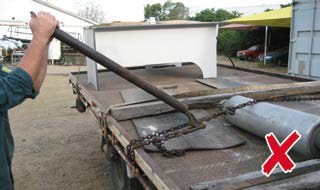
Worker using dog and cheater bar.
The risks include:
Possible solutions include:
See Cheater bar on dogs safety alert.
Falls are a major cause of death and serious injury in Australian workplaces.
Most people who are seriously injured or killed, fall from a height of four metres or less.
In the transport industry, workers engaged in loading/unloading and maintenance tasks are placed at risk if working from the tray or trailer, including climbing over or around loads.
Certain work tasks introduce fall from height hazards and require risk management. Examples include:
Several businesses and workers may be involved in loading and unloading freight, such as:
Under the work health and safety laws, each business shares responsibility for the health and safety of those involved in the work, to the extent of their capacity to influence and control the work.
Everyone must work together to ensure the risks associated with working at heights are eliminated, or if this is not possible, minimised.
There are specific laws about working safely at heights: See clauses 78 – 80 of the Work Health and Safety Regulation 2017.
There are also general work health and safety laws that will apply to you in any situation, including when working at heights.
Read the Code of practice – Managing the risk of falls at workplaces or the simple safety tips for working at heights fact sheet to learn more.
Whether it’s a routine task or a one-off job, you and your workers should stop and plan the work to eliminate or control the risk of a fall.
Wherever possible, perform the work from ground level.
When planning the work, look for alternatives that eliminate or minimise working at height.
If the need to work from a height cannot be eliminated, you must manage the risk of a fall.
Use measures to prevent a fall, such as:
You must consult with your workers when:
Listen to your workers' views on how to safely perform the work and draw on their experience and ideas.
When buying a new or used vehicle, ensure that its design supports all the risk controls above.
Truck steps with dual handrails installed.
Cab lighting to illuminate entry/exit point.
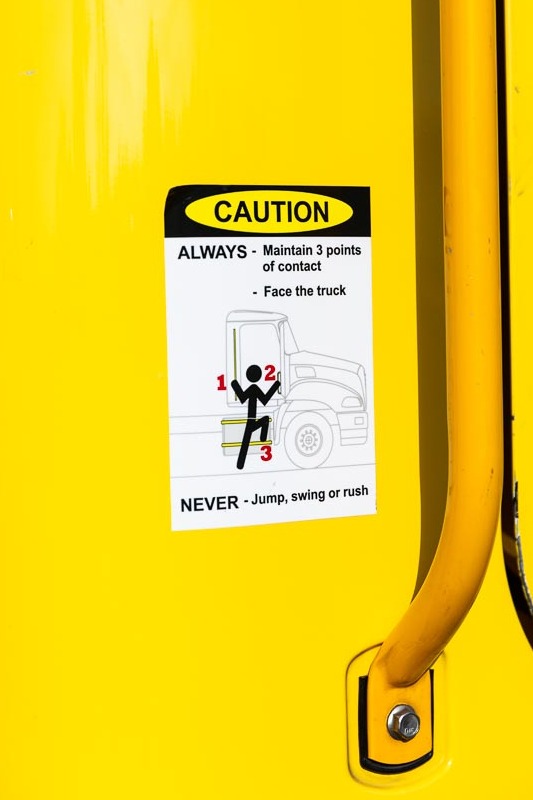
Decal on cab showing 3 points of contact required.
To reduce the height at which drivers need to access a load and to allow access to anchor points, some trucks are fitted with retractable or foldaway steps.
They reduce the risk of sprains, strains and falls at lower levels.
Portable step platforms are also available for use.
Retractable steps to access a tray.
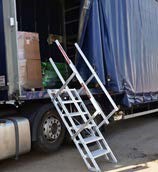
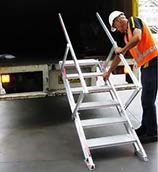
Truck access solution.
Wherever possible, enable your workers to work from the ground as this is the best way to prevent falls from height.
If unable to work from the ground, then a safe way to access and work on the trailer must be provided. This can include safety equipment such as guard rails, work platforms, retractable ladders or steps with handrails.
Many vehicles today have been designed or modified so that drivers do not have to work at heights. For example, some fuel trucks and bulk-liquid tankers have valves, fittings and hoses located so that filling and dispensing can be carried out from ground level. Many tip trucks and trailers are now fitted with tarping systems that are operated from ground level. Tarping of general cargo can also be undertaken from ground level by using tarping gantries or tarp spreaders mounted on a forklift.
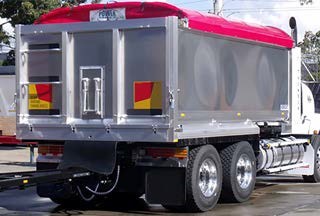
Automated tarp controlled from cab.
If working at height is unavoidable, you need to manage the risk of a fall. A fall prevention device is best because it will prevent your workers from falling. Examples include temporary work platforms and guard rails installed on vehicles.
Some guard railing designs can fold flat until required.
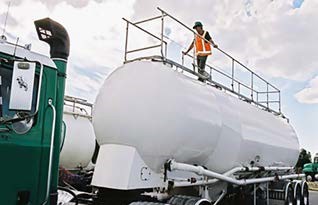
Pneumatic guard railing installed on tanker.
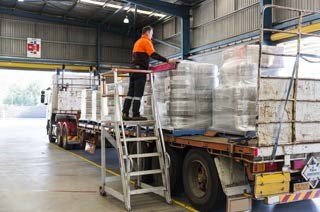
Mobile truck access platform.
Work-positioning systems with harnesses are common. Some workplaces have installed overhead frameworks that provide anchor points or cables, to which the fall protection device is attached before accessing the tops of vehicles. Proprietary anchor points must be installed in accordance with manufacturer’s instructions.
These structures are very effective but only if drivers and workers are trained in these systems.
Anchor points or cables in the containers or on the trailer are also popular. They allow drivers to clip a harness on and undertake inspections of their load with reduced risk of falling to the ground. Some are work-positioning systems, others are only fall arrest systems.
Work-positioning systems, such as travel-restraint systems, are preferred as they substantially reduce the risk of a fall by not allowing the person to move beyond a designated point.
A fall arrest system restricts the distance a person can fall but does not prevent the fall.
Only use a fall arrest system if a work-positioning system, guard rail or elevated work platform is not practicable – and only if a person can be rescued immediately.
If a fall occurs, a person using a fall arrest system could suffer suspension intolerance from being suspended in a harness. Workers must be provided information training and instruction in relation to the use of these systems and related equipment.
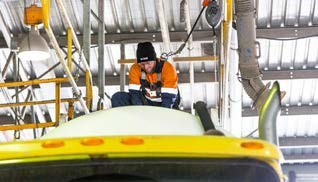
Fall arrest system.
Whenever there are risks from working at height, emergency procedures must be established, and first aid equipment provided.
Typical injuries from falls can include unconsciousness, blocked airway, impalement, serious head or abdominal injuries and fractures.
The procedures must be tested so they are effective. Workers must be provided with suitable and adequate information, instruction and training in relation to the emergency procedures.
Emergency and rescue may be more straightforward at a fixed location such as a depot or loading facility, but can be difficult if the driver has stopped on the side of the road. In this instance, procedures should be in place so that, where possible, the driver stops at a location with other people in attendance, to assist in case of a fall.
Non-driving tasks performed by drivers and those involved in the maintenance of vehicles can involve serious risks to health and safety.
Checking loads or performing maintenance on the roadside creates serious risks to both the driver and other road users.
Persons have been killed and sustained serious injuries as a result of undertaking inspection and maintenance work on the side of the road.
All vehicles should be regularly inspected and maintained by a competent person to ensure they are safe and roadworthy. This keeps drivers safe and minimises the risk of a driver needing to undertake ‘unscheduled maintenance'.
A truck driver was fatally injured when he was trapped between the bottom well deck and the chassis rail of a heavy vehicle transport trailer in a carpark at Kirrawee.
Read the Incident Information Release.
The transport trailer involved in the incident.
When working on or under vehicles implement ‘reasonably practicable’ control measures to manage the risks associated with working under an elevated truck cabin, which includes developing safe systems of work. Ensure that:
You must supply the necessary information, training and supervision to all your workers so they can perform their work safely.
Training should be an ongoing process. When young workers are involved, there are other factors to consider. See the At-risk workers section.
An 18-year-old apprentice auto electrician died after becoming trapped between the cab of a truck and its engine, at a workshop in Brocklehurst, north of Dubbo.
Read the Incident Information Release.
Truck involved in the incident.
A potential hazard when working on vehicles with hydraulics is being crushed.
Contributing factors can be:
Examples of hydraulic risks are outlined in WorkSafe Queensland's Hydraulics safety.
If undertaking any work under heavy vehicles and trailers, ensure appropriately designed and engineered load supports are used (e.g. stands or lifting devices).
Before beginning work, always identify hazards and assess risks associated with working under and around heavy vehicles or trailers. Where appropriate:
Similar risks exist for light vehicles and a risk assessment should be conducted before beginning work.
Air-filled tyres can explode when over pressurised or defective and have caused serious injuries and deaths.
Whether new or used, tyres need to be checked for defects before fitting onto a rim or wheel.
Defects may include:
All defective tyres should be disposed of appropriately.
You may not be able to see all defects during an inspection, so take care when inflating. If a tyre has been overloaded, or the pressure has dropped below 80%, deflate the tyre, remove the tyre from the rim and inspect it before refitting and inflating it.
Running with pressure below 80% (or overloading) can lead to fatigue failures, like zipper failure (a circumferential fracture of the sidewall of the tyre).
For dual-wheel assemblies, it is hard to see if the pressure of one tyre has dropped below 80% of the recommended pressure, so always use a gauge to measure the pressure.
When inflating:
Compressed air is used for inflating tyres.
Air receivers can explode and cause serious injuries or death if they are not properly inspected and maintained, or if they have been used above the design pressure.
The Safe Work Australia compressed air and air receiver information sheet provides further guidance for workers who use large or small scale air compressors and air receivers.

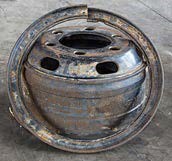
Left: Multi-piece split rim. Right: Split rim ring and wheel.
Split rims are different from regular wheels found on most cars. Most cars we drive have wheels that have a single piece of metal with the rubber tyre inflated around it (which is then secured to your vehicle).
Split rims are multi-piece-or-divided rims and wheels that are held together by bolts or a lock ring. Split rims are generally used in large trucks.
If you have split rims, it’s very important you deflate the tyre before removing it from the vehicle and take care when inflating, otherwise they can explode causing serious injury or death.
Remind your workers about the dangers of split rims by placing warning stickers above each of the tyres on your vehicles.
You can buy them from the online publications store. The first 100 ordered are free.
The Safe Work Australia guide for split rims provides more information on how to manage the risks associated with split rims.
You can also watch our split rims video safety alert.
If you operate and maintain low loader trailers, make sure:
In April 2020, a 54-year-old truck driver was crushed by a loading ramp and died while unloading earthmoving equipment from a low loader.
Read the Incident Information Release.
Vehicle with low loader ramp involved in the incident.
Significant safety issues are attributed to broken down vehicles along the roadside. This can present considerable safety risks; challenging the road freight transport industry and the general public.
Potential safety issues arise when vehicles break down and where vehicle and people interactions occur including towing arrangements.
When undertaking work on a public road, your work health and safety obligations still apply, but you must also adhere to the requirement and framework of the Australian Road Rules.
Breakdown events and their locations are usually unforeseeable, but actions can be taken to minimise the risks to the driver and the public. Elimination of any breakdowns in the first instance is the best option.
Truck inspections and the required maintenance is fundamental in reducing the likelihood of a vehicle breaking down. If you are required to stop the truck because of a situation this usually can be undertaken by the driver with minimal risk.
Other considerations for the breakdown location include:
It is also important to secure the scene once a truck has come to a stop. The truck driver should take reasonable steps to ensure neither they nor the truck are in danger. Consideration also needs to be given to the surrounding environment and measures should be taken to minimise the impact on other road users, nearby premises and the public.
Ensure workers are prepared for a roadside emergency. Workers should be trained (including refresher training) and fully equipped to work safely in the event of a breakdown.
Workers should be trained in:
Communication options include:
Ideally, any breakdown location should allow 3 metres or greater of clearance from passing traffic.
Drivers need to assess the location to ensure that any inspection and repair work can be undertaken safely.
If safe clearance cannot be achieved and other control measures are not effective, consider:
In the event of a truck breakdown, the driver and truck must be seen by passing motorists and other road users.
Drivers should ensure they are wearing high visibility clothing and PPE if leaving the cabin of the vehicle.
It is recommended to exit the truck cabin from the left side door.
There are road safety requirements relating to warning other drivers. This may include turning on hazard warning lights and displaying warning triangles at required intervals for the road type.
Use of emergency equipment such as triangle and portable warning lights will also reduce the driver’s exposure to passing traffic.
Refer to WorkSafe Victoria’s Truck emergency breakdown and roadside safety for more information.
In addition, drivers should follow any breakdown policies and procedures the business has in place.
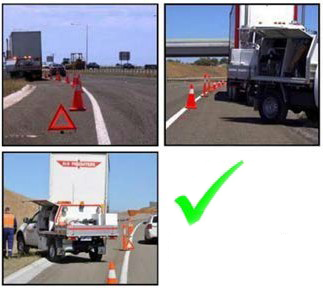
Using traffic bollards with triangles can create a visible barrier between workers and passing traffic.
Inadvertent starting or movement of the vehicle must be prevented.
The truck should be properly immobilised through use of the park brake and wheel chocks.
Do not attempt to gain access to the vehicle if the vehicle starts to roll.
Dangerous goods, hazardous chemicals/materials and livestock can bring additional hazards to the driver and persons nearby in a breakdown event.
These additional hazards should be considered in your ongoing risk assessment for breakdown events, and control measures should be tailored to manage these risks.
Your business should be prepared for any roadside emergency and have clear instructions available on what steps to take.
Debris created by a breakdown event can pose a significant danger to other road users.
Prior to leaving the site, any remaining materials such as tyre tread should be removed if it is safe to do so and properly disposed of.
In an emergency, workers need to be able to raise the alarm and be contactable.
Truck drivers often work remotely or in isolation, where they may be unable to get immediate attention from rescue, medical or emergency services.
You must have a safe system of work that includes effective communication with the driver which allows them to call for help in the event of an emergency.
Monitor your workers regularly, with phone calls or periodic visits. Have a check-in process whereby workers are required to contact ‘home base’ at a nominated time and have an emergency response plan when workers do not report in at allotted times.
For the specific laws about doing remote and isolated work, see clause 48 of the Work Health and Safety Regulation 2017.
Work-related musculoskeletal disorders (WMSDs) are common among workers in the road freight transport industry, with drivers being one of the most at risk occupations.
WMSDs consist of injuries to muscles, tendons, ligaments, the nervous system, blood vessels, joints and bones.
Workers are exposed to a risk of a WMSDs from manual tasks, repetitive movements, forceful exertions, awkward postures, prolonged sitting, exposure to vibration and psychosocial hazards (such as high job demand, low job control, pace of work etc).
The best course of action is for businesses to adopt a risk management approach to eliminate and minimise the risk of WMSDs occurring. As workers are exposed to a variety of risk factors, control measures and systems of work that address these multiple factors are needed to protect workers from harm.
Not all manual tasks are hazardous. It is therefore necessary to identify those tasks that are hazardous and ensure they are adequately managed.
A hazardous manual task is a task that requires a person to lift, lower, push, pull, carry or otherwise move, hold or restrain any person, animal or thing involving one or more of the following:
Some of the most common sources of WMSD risk within the transport industry are:
Each business needs to adopt a systematic, risk management approach to managing WMSD risks.
For the above to be effective, consultation with your workers is paramount.
Your workers are the best source of information about the risks they are exposed to daily. They can provide valuable insights about discomfort, muscular aches and pains that can signal potential hazards. They can also provide valuable information on how to fix the problem.
There are specific laws about managing WMSDs: See clauses 60 - 61 of the Work Health and Safety Regulation 2017.
There are also general work health and safety laws that will apply to you in any situation, including when managing WMSDs.
When workers must perform a manual task (such as handling freight), there are certain risk factors that make it hazardous. These are:
When workers are exposed to these risk factors, there is a greater risk of WMSDs.
Drivers are at an increased risk due to the unique nature of their work. They may be exposed to long bouts of static postures and vibration (while driving their vehicle), followed by intense hazardous manual tasks (handling freight, securing loads, handling gates, curtains etc.)
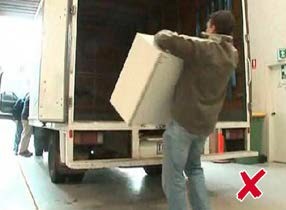
Worker attempting to place a load into a truck. No tailgate lifter is installed, significantly increasing manual handling risk.
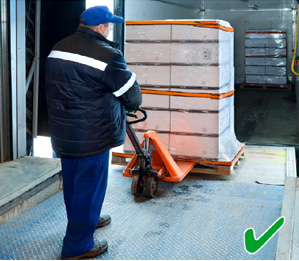
Worker operating pallet jack with tailgate lifter fitted, at loading ramp.
When the manual task becomes hazardous, you need to understand why. To do this, you need to identify the source of the risk associated with the hazardous manual task.
These sources of risk are outlined below, and a business has a legal obligation to consider these when determining control measures. Businesses must consider all relevant matters that may contribute to a WMSD. These may include:
Several businesses may be involved in loading/ unloading freight, such as:
Under workplace health and safety laws, each business shares responsibility for the health and safety of those involved in the work, to the extent of their capacity to influence and control the work.
Everyone must work together to ensure manual handling risks are eliminated, or if this is not possible, minimised.
The transport operator should:
The business where freight is loaded/unloaded should talk to:
The physical toll of sitting in and operating the vehicle must be identified, assessed and controlled. Drivers should receive suitable information, training and instruction on the features of the vehicle they will be operating.
Ensure the vehicle and cab are designed to fit the driver and reduce MSD risks. Features inside and outside the cab should be fit for purpose and adjustable (where required) to achieve this. This should be a part of your vehicle procurement procedure.
Vehicle maintenance is integral for the roadworthiness of the vehicle and also for certain WMSD risks such as vibration.
Ensure any equipment that is purchased and installed does not increase postural and cognitive demands on the driver.
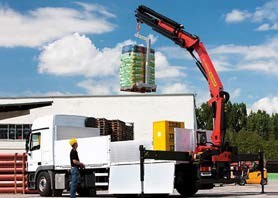
Use of pallet lifter attached to vehicle loading crane to unload materials from a truck.
It used to be thought that WMSD risk arose only from the physical demands of work, particularly ‘manual handling’ tasks requiring forceful or highly repetitive actions.
It is now known that WMSD risk is also strongly influenced by the physiological effects of stress from workplace factors known as psychosocial hazards.
Some examples of psychosocial hazards that impact WMSD in the transport sector are:
Effective management of psychosocial hazards can assist in minimising WMSDs in your workplace.
There are many benefits to having a mentally healthy workplace and these extend to workers, the business and the wider community. When a business is proactive and prevention focused they can see a return on investment for every dollar spent to improve mental health at work.
Mentally healthy workplaces will also consider mitigating factors for all workers (including, for example, injured workers or workers who have disclosed mental illness to the workplace) to be able to connect workers with early support and help their recovery at work.
The key to creating a mentally healthy workplace is identifying psychosocial hazards in the organisation’s work practices, work environment and work activities, and assessing the risk in consultation with your workers about the best way to manage the risk of these hazards. Businesses must also consider the cumulative effect of work demands and risk factors over time.
The benefits of taking a risk management approach to psychosocial hazards include:
The most effective way to get started is to have a conversation with your workers and talk through any concerns they may have.
If there are psychosocial hazards at work this is a good opportunity to offer support. Other ways to identify psychosocial hazards include staff surveys, hazard and incident reporting.
It is important to remember that you have legal obligations relating to managing psychosocial hazards that include work health and safety as well as preventing discrimination and protecting privacy.
Supported workers have increased confidence, a feeling of belonging, financial security, a sense of purpose, achievement and social connections and networks. These benefits can flow back into the business in many ways including increased productivity, reduced injuries and positive workplace culture.
Your workers may benefit from access to an employee assistance program (EAP) or the opportunity to speak with trained professionals, such as counsellors or psychologists, who can provide support and help build skills to stay mentally healthy.
Some larger workplaces may be able to provide these services in the workplace, while smaller businesses may choose to refer their workers to external professionals.
Support services and tools are available to help you and your team to stay mentally healthy and recover at work.
A mentally healthy workplace has the following principles and behaviours:
By adopting a risk management approach to workplace mental health you are:
The NSW Mentally healthy workplaces strategy 2018- 2022 sets out a long-term vision to create mentally healthy workplaces across NSW.
Support is available to help create a mentally healthy workplace.
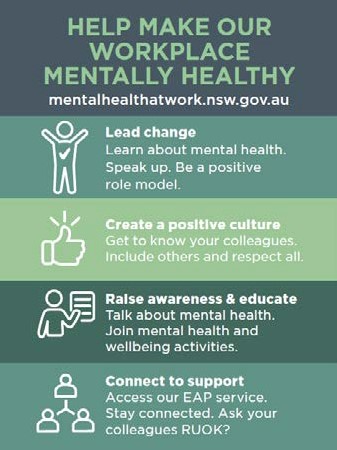
Visit the Mental health at work website for more information on your duties, as well as resources to promote, manage and support workplace mental health.
The following organisations provide crisis support and help:
Psychological and physical health are inter-connected. One may lead to the other.
Recognising and managing risks in the workplace that may lead to physical or psychological injury is an essential part of creating a safe, healthy and productive workplace.
Work in the transport industry typically includes working alone, tight scheduling, and demanding customer expectations and these are factors that may contribute to poor psychological and physical health.
Psychosocial hazards or factors are anything in the design or management of work that increases the risk of work-related stress.
A stress response includes the physical, mental or emotional reactions that occur when a worker perceives the demands of their work exceed their ability or resources to cope. Work-related stress if prolonged and/or severe can cause both psychological and physical injury.
By knowing what these hazards are and how to identify them in your workplace you can identify and implement controls that look after the psychological and physical health of your workers.
Psychosocial hazards can arise from organisational factors (work organisation, job design and poor workplace culture), environmental factors and individual factors (e.g. at-risk workers).
Below are the types and some examples of psychosocial hazards:
Low job control
High and low job demands
Exposure to traumatic events
Poor support
Lack of role clarity
Low levels of recognition and reward
Poor change consultation
Poor organisational justice
Poor workplace relationships
Remote work
The transport industry is diverse, made up of people of different skills and experience who work under different employment arrangements.
There are some workers who might be at greater risk of injury or illness while working and they may need extra support and consideration to stay healthy and safe at work.
There are four groups of workers who are most at risk of being injured at work:
| At-risk groups | Highest risk factor |
|---|---|
| Young workers | Inadequate supervision and training |
| Culturally and linguistically diverse workers | Language barriers hinder understanding of work health and safety rights and worker obligations |
| Migrant workers | Language barriers hinder understanding of work health and safety rights and worker obligations |
| Labour hire workers | Commonly assigned higher risk work |
You must look after the physical and psychological health and safety of all workers:
Download the At Risk Workers’ Strategy 2018-22 to find out more.
When young workers are involved, make sure you consider their:
You can visit our young workers eToolkit to access a range of resources that have been specifically developed to support young workers’ safety.
SafeWork NSW has produced a fact sheet ‘Your Rights At Work Fact Sheet’ which explains the basic responsibilities of the worker and the employer.
This fact sheet and other resources are available in multiple languages including Arabic, Korean, Hindi, Filipino, Chinese, Punjabi and Malay.
Fatigue can affect safety in the workplace and is a significant risk in the transport industry, particularly for drivers. It can impact on workers psychological and physical health, as well as the health and safety of those around them, such as co-workers, customers and members of the public.
Fatigue can increase the likelihood of incidents and injuries, particularly when doing safety critical tasks where significant consequences may arise if errors occur.
Fatigue can result in reduced productivity and an increase in near misses, incidents, injuries and fatalities, even when the signs of fatigue may not be obvious. Some workers and particularly drivers are at a higher risk because their work involves many factors that contribute to fatigue.
Fatigue can be caused by:
Symptoms of fatigue include:
How fatigue affects your performance at work can be likened to how alcohol affects your performance. If you’re awake for 17 hours your performance at work would be impaired to the same level as having a 0.05 blood alcohol content. If you’re awake for 20 hours, it’s the same as having a 0.1 blood alcohol content.
The long-term health effects of fatigue can include high blood pressure, heart disease, type 2 diabetes and depression.
Early warning signs of fatigue while driving include:
Fatigue can be caused by work or non-work-related factors or a combination of both. Work-related fatigue may result from:
Non-work related fatigue for example could include fatigue due to long transit times or poor-quality sleep due to family demands or street traffic noise.
Generally, workers are most active and productive during the daytime.
The circadian rhythms (the body clock) cause regular variations in individual body and mental functions that regulate sleeping patterns, body temperature, heart rate, hormone levels, digestion and many other functions.
These rhythms influence job performance and quality of sleep. Most of the body’s basic functions show maximum activity by day and minimum activity by night. The body rhythms affect the behaviour, alertness, reaction times and mental capacity of people to varying degrees.
Driver fatigue is one of the top three contributors to the road toll. Research has shown that fatigue can be as dangerous as other road safety issues, such as drink driving.
Fatigue may increase the risk of incidents because of a lack of alertness. It may result in a slower reaction to signals or situations and affect a person’s ability to react, and make good decisions, particularly when:
If operating a fatigue-regulated heavy vehicle, ensure daily work activities and rest periods are accurately recorded in accordance with legislative requirements.
Learn more on the National Heavy Vehicle Regulator website.
Businesses must ensure, so far as is reasonably practicable, the health and safety of workers while they are at work. This means if fatigue is identified as a risk to work health and safety, then suitable control measures must be implemented in consultation with workers to eliminate or minimise the risks.
The Guide for managing the risk of fatigue at work provides practical guidance for businesses and other duty holders on how to manage fatigue to ensure it does not contribute to health and safety risks in the workplace.
Transport for NSW has a fact sheet on managing fatigue. These tips to avoid driving tired may help you and your workers plan ahead to ensure fatigue is managed.
Stop Revive Survive can help your drivers to detect the early warning signs of fatigue when driving and locate rest areas in NSW.
Driver Reviver sites operate throughout Australia during school/university holidays with places to take a break.
Interactive rest area maps allow you and your drivers to plan rest stops, while a Trip Time Calculator provides a quick guide to journey lengths. Remember to add extra time for sufficient breaks for your drivers.
A 52-year-old truck driver was fatally injured in northern NSW at a changeover location.
The driver was crossing the road at night, which at the time of the incident, was lined with trucks on either side. A heavy vehicle driving in the middle of the road struck the driver who was not wearing high visibility clothing at the time.
Read the incident information release.
Businesses must ensure, so far as is reasonably practicable, that adequate facilities are provided for workers, including sufficient toilets, drinking water, washing and eating facilities.
In the transport industry, drivers are often reliant on offsite facilities and those available at other workplaces.
When managing your drivers’ ability to access suitable facilities, consider the following:
These provided facilities (amenities) must be in good working order. This includes access to amenities that are clean and safe, have accessible toilets, clean drinking water, handwashing facilities, eating and break facilities, first aid equipment, and may include secure storage for personal items.
Additional guidance can be found in the Code of Practice Managing the Work Environment and Facilities.
You must provide workers access to first aid equipment and facilities. Keep first aid kits close to areas where there is a higher risk of injury or illness, such as the amenities, warehouse and inside all work vehicles.
Additional first aid requirements vary depending on the nature of the work, type of hazards, workplace size and location, as well as the number of workers. To identify your requirements, see the Code of practice for first aid in the workplace.
Drugs (including prescription drugs), alcohol and other substance abuse in the workplace and within the transport industry is, as with any health and safety risk, everyone’s responsibility.
Driving under the influence of a drug or alcohol is an offence under section 112 of the Road Transport Act 2013 (NSW).
Under NSW work health and safety legislation, workers need to ensure they take reasonable care of their own health and safety and not put others at risk. This includes complying with drug and alcohol laws and co-operating with any reasonable business policies.
In some occupations including road and rail transport, maritime, aviation and mining occupations, the law sets down a legal blood alcohol level and requires testing of workers. You need to manage the work-related risks associated with alcohol and other drugs.
Some companies have explicit policies to test their workers for alcohol and illicit substances. This is particularly important if a worker could kill or seriously injure themselves, another worker, or a member of the public.
It is dangerous for drivers to take stimulants and other illegal drugs. Cannabis, cocaine and similar drugs affect driving skills and concentration, even though you may think you are driving well.
This includes the misuse of medicines prescribed by a doctor or available from a pharmacy. If a worker is impaired at work, the business needs to address the situation. It should be raised with a supervisor or manager or a safety representative.
It is the worker's responsibility to notify the business if they are taking medication that may affect their ability to safely perform tasks.
A formal alcohol and drugs policy makes it clear to all workers what behaviour is acceptable.
The alcohol and other drugs in the workplace guide has information on how to create a policy for managing the misuse of alcohol and other drugs in the workplace.
The Safe Work Australia website has information on work-related alcohol and drug use.
The National Centre for Education and Training on Addiction (NCETA) has also produced a series of data and information sheets to assist workplaces to respond to alcohol and other drug (AOD) related harm in the workplace.
Sedentary work, such as prolonged sitting, poses significant health risks in the transport industry, with drivers sitting for most of their shift.
Australian workers spend approximately 76% of their time at work sitting (or 5 hours per day). A quarter of the population say they spend 8 hours a day sitting.
Sedentary work and long working hours can result in a low level of wellness, as it may lead to workers having a poor diet, low levels of exercise, increased alcohol and drug use, or fatigue.
Interestingly, exercise performed outside of work does not negate the risks factors of prolonged sitting. Safe Work Australia has identified sedentary work as a priority issue that can affect workers’ health and safety.
The Sedentary Work: Evidence on an emergent work health and safety issue report focusses on sedentary behaviour in the workplace – not just among office workers, but also in the manufacturing, transport and storage, construction, agriculture forestry and fishing, and health and community services sectors.
The report suggests occupational sitting is likely to be a common hazard in Australian workplaces.
Occupational sitting is linked to significant negative health and work outcomes and is increasingly being recognised in the community and by international authorities as an important issue that needs attention.
Sedentary work can increase the risk of:
When sitting for long periods, workers report feeling tired, less productive and unhealthy.
There are several initiatives you can bring to the workplace to enhance the mental and physical wellbeing of your workers, such as:
A successful workplace health program can have many benefits, including:
The reliance and use of technology and social media in recent years have led to the increased use of smartphones and associated technologies in road transport.
In NSW, using a hand-held mobile phone while driving is illegal. This includes when waiting at traffic lights or stopped in heavy traffic.
Road Transport legislation prohibits the use of certain handheld communication devices. Technology should be assessed to ensure it is safe and lawful for use.
Find answers to common questions about mobile phone road rules on the Transport for NSW website.
Hazardous chemicals transported on the road must meet the packing and labelling requirements of the Australian Dangerous Goods Code.
More information about the safe transport of hazardous chemicals is available from the NSW Environment Protection Authority (EPA).
Dangerous goods are substances and objects that pose acute risks to people, property and the environment due to their chemical or physical characteristics.
The EPA regulates the transport of dangerous goods in NSW.
When transporting dangerous goods you need training and may need a licence for both the driver and the vehicle. If you are transporting waste, you may also need a waste transporter’s licence.
All licence holders are listed in the dangerous goods public register, on the EPA website.
You must also follow certain procedures to ensure the goods are transported safely. There are penalties for not following these legal requirements.
Explosives transported on the road requires an explosives licence in NSW.
Explosives licences are administered by SafeWork NSW under the NSW Explosives Regulation. The regulation provides for the licensing of corporations or individuals who wish to transport explosives and/or security sensitive dangerous substances (SSDS).
Under the NSW Explosives Act, if the NSW Explosives Regulation requires a licensed person to handle explosives and explosives precursors, it is an offence for an unlicensed person to handle such material.
For additional information about applying for a transport explosives and/or SSDS licence, contact SafeWork NSW on 13 10 50 or visit the website.
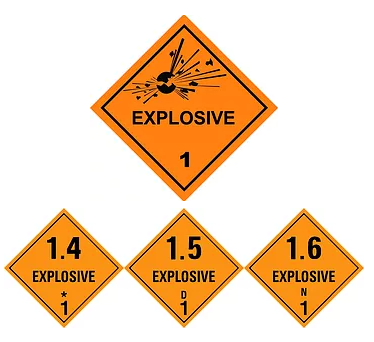
Almost 30% of workplace fatalities in NSW are the result of road crashes at work, while about 26% of the state road toll involves a vehicle being used for business.
Road Safety and Your Work: A Guide for Employers will help your organisation establish internal policies and practices for safe work-related travel.
Employers have a primary duty of care to provide and supervise a safe system of work under the Work Health and Safety Act 2011.
In February 2018, the NSW Government released the Road Safety Plan. This was developed to set new road safety priorities and actions to help NSW work toward the State Priority Target for a reduction in road fatalities.
In support of the Road Safety Plan a guide has been developed that provides workplaces with information about key road safety issues and risks, and ways to help you and your workers get around safely while using the road. It also provides information to help you embed road safety within your workplace.
To further support employers, the Road Safety in Your Workplace program has been developed. It consists of an online employer toolkit to aid your organisation in embedding road safety in your workplace. This program also contains an interactive eLearning course for your workers, supporting case study videos that showcase good practice employers, toolbox talks for delivery by your leaders, checklists, templates, as well as fact sheets targeted at your workers.
Further supporting resources have been developed to help organisations to embed road safety in the workplace:
On average, injured or ill workers in the transport industry are taking longer than most other industries to recover at work.
SafeWork NSW and SIRA are working together with industry to improve practices to support injured or ill workers to recover at work.
Helping workers recover at work can benefit both employers and workers. Benefits can include:
Having a planned and consistent approach to support injured or ill workers is good for business, and a legal requirement known as a ‘return to work program’.
A return to work program is the policy and procedures for handling any work-related injury or illness. It represents your commitment to the health, safety and recovery of workers following an incident.
All employers in NSW must have a return to work program within 12 months of starting a business.
Your program must follow the State Insurance Regulatory Authority’s (SIRA) guidelines for workplace return to work programs.
The SIRA website has detailed information on what is required in a return to work program and how to set one up.
If you have five or fewer workers and a workers’ compensation premium of $30,000 or less, SIRA has a program to assist.
The Recover to work assist program for micro employers helps businesses who find it difficult to provide suitable duties for injured workers.
SIRA also provides several vocational rehabilitation programs and a useful fact sheet on supporting workers to recover at work.
Work is an important part of rehabilitation. It is a therapeutic intervention and should be used as part of a worker’s treatment when they are recovering from a workplace injury.
The longer a worker is off work, the less chance they have of ever returning. Research has shown that after a workplace injury, the injured worker has:
Employers within the transport industry can assist their injured workers to recover at work by providing suitable duties. Depending on the injury and medical capacity, recovery, work and suitable duties can include:
Assessing the truck operated by the driver can help identify alternative strategies for recovery at work dependent upon the barriers for recovering at work.
Some examples may include the injured worker’s ability to:
Solutions could include an ergonomic assessment with recommendations for an alternative seat, hanging truck gates and temporarily changing the injured workers truck with another truck while the injured worker undergoes rehabilitation.
For some injuries, there may be a delay in starting suitable duties. During this time it is important to stay in contact with your injured worker so that they know they are supported to recover at work when their medical capacity supports this.
For psychological injury, there is a web-based toolkit for workplaces that offers easy, practical help which is evidence-informed and guided by the voice of lived experience.
Job title: Interstate truck driver.
Driver: Responsible for driving a truck from Sydney to Brisbane, the Depot was located between Sydney and Brisbane.
Injury: Injured worker twisted his knee and sustained a knee injury while walking backwards and pulling truck curtains.
Pre-injury days and hours worked per week: 6 days a week, Monday to Friday 12 to 14 hours per day and Sunday 6 to 8 hours per day.
Employer: The employer was supportive of return to work. The employer was concerned about the impact of the claim on workers compensation premiums and was willing to support a progressive return to work. The employer requested the aid of a Rehabilitation provider who through liaison with the injured worker’s nominated treating doctor and treating physiotherapist established the injured workers capacity, recovery time frames and return to work times frames.
A progressive suitable duties/recover at work plan was developed and agreed to by the injured worker, employer and treating doctor following a workplace assessment. The worker was able to gradually return to work as per the progressive recover at work plan below.
Hours worked: 5 hours per day, 3 days a week
Number of weeks: 2 weeks
Suitable duties to be performed:
Hours worked: 8 hours per day, 3 days a week
Number of weeks: 2 weeks
Suitable duties to be performed:
Hours worked: 8 hours per day, 5 days a week
Number of weeks: 3 weeks
Suitable duties to be performed:
Hours worked: Pre-injury hours and days
Number of weeks: 2 weeks
Suitable duties to be performed:
Commenced pre-injury duties and pre-injury hours.